Updated
X
Bluesky
Copy link
Impact Link
Save
Saved
Read in app
subscribers. Become an Insider
and start reading now.
Have an account? .
- The USS Gerald R. Ford is the world’s largest aircraft carrier.
- We toured the carrier — the most technologically advanced to date — at its home base in 2017.
- The Navy just ordered the carrier to the Caribbean amid the US’ escalating tensions with Venezuela.
The USS Gerald R. Ford isn’t just the US Navy’s largest aircraft carrier — it’s also the largest in the world.
Commissioned in July 2017, the first of the Ford-class carriers is more technologically advanced than Nimitz-class carriers.
It has an improved hull design and weapons stowage, a new weapons elevator, more space on the flight deck, a new electromagnetic-powered aircraft-launch system, three times the electrical-generation capacity of any previous carrier, and a lot more.
And now it’s heading to the Caribbean amid the US’ escalating tensions with Venezuela, which the Trump administration has accused of engaging in drug trafficking.
On Friday, the Pentagon announced the USS Gerald R. Ford would be joining other US ships in the US Southern Command’s area of responsibility. It’s traveling from Europe, where it’s been supporting NATO exercises.
We visited the supercarrier when it was docked in its homeport of Virginia’s Naval Station Norfolk in 2017.
We first saw the USS Gerald R. Ford from shore as it was stationed at a harbor in Naval Station Norfolk.
The Ford, which stands about 134 feet tall, towered over us.
It was docked next to the USS George W. Bush.
It was also docked next to the USS Truman and USS Lincoln.
US Navy spokesman Corey Todd Jones, who showed us around the Ford, led us to the entrance seen below.
First, we had to go past a security checkpoint, but we were not allowed to take photographs of that area.
The entrance led to a massive hangar bay.
Aircraft are stored here when not in use.
This is one of the advanced weapons elevators.
The elevators connect to the flight deck and allow sailors to move ordnance from the magazines to the aircraft.
We were not allowed to photograph down the elevator because it’s classified, but you can read more about the elevators here.
A statue of former President Gerald R. Ford stands in the hangar bay.
Ford served as a navigation officer on the USS Monterey during World War II. His shipmates credited him with saving the ship during a bad storm, Jones said.
Jones then took us up to the flight deck.
This area is 256 feet wide and 1,092 feet long.
The only aircraft there was a “dud” — an F/18 Hornet stripped of its engine and components.
It’s now used by the signalmen to practice flight-deck operations and moving aircraft.
The afterburners have been stripped.
Here’s a closer look of the hollowed-out engine.
This E-2C Hawkeye flew over us outside Norfolk Naval Station earlier in the day.
Hawkeyes are US spy planes that are often assigned to carriers.
Carriers are always assigned a Carrier Air Wing, which generally consists of about nine squadrons and five different kinds of the following aircraft.
This compartment, which can be raised and lowered, is called the Integrated Catapult Control System or “bubble.”
Officers in here launch the jets after getting the all clear from the signalmen.
There are a number of Bomb Jettison Ramps, or emergency evacuation “chutes,” which sailors can use to offload misfired ordnance.
These were added to carriers after the 1967 fire aboard the USS Forrestal. The Forrestal was in the Gulf of Tonkin when an F-4 Phantom misfired a rocket, resulting in a huge fire that killed more than 100 sailors.
The sides of the flight deck can be rather perilous.
It completely drops off into open waters on most sides.
The Ford is also equipped with multiple Sea Sparrows.
These are short-range antiaircraft and missile systems.
As well as Rolling Airframe Missile systems.
There are also Close-In Weapons Systems aboard, but they were covered up.
From here, Jones took us up in the tower.
Its position on the flight deck ensures maximum space for aircraft and operations. (The USS Gerald R. Ford can carry more than 75 aircraft.)
We entered the flight-deck control, where the handling officer manages the arrangement of aircraft.
This task is done on computers now, which we weren’t allowed to photograph, but it used to be done on this “Ouija board,” still used as a backup.
When notable people visit the Ford, like President Donald Trump, they often autograph US currency.
Those notes are then placed along the borders of the Ouija board.
We then went up to the bridge, where the ship is navigated.
The Ford is powered by two nuclear reactors that can bring it to speeds of over 30 mph.
This is the lead helm, which controls the speed and steering.
It’s all digital, but there’s an actual steering wheel below for back up.
The navigation officer sits next to the chart table.
The ship is navigated digitally and with the paper charts, Jones said. A two-minute video shows Jones explaining more about the Bridge and its devices.
We also got a great view of the Truman and Lincoln carriers from the bridge.
At this point, we had been onboard for a couple hours and our time was up. But on the way out, we saw one of the bathrooms.
And it’s true: The Ford doesn’t have urinals. You can read more about why here.
Read the full article here


